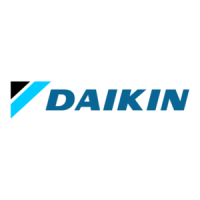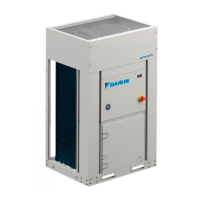DEIMHP0140521_00EN
4
EWYT~CZ / EWAT~CZ
1. introDuCtion
This appliance is intended to be used by expert or trained users in
shops, in light industry and on farms, or for commercial use by lay
persons. The appliance shall not be accessible to the general public:
install it in a secured area, protected from easy access.
This manual provides information on the standard functions and
procedures of all units in the series and is an important supporting
document for qualified personnel but can never replace it.
All units are delivered with wiring diagrams, certified drawings,
nameplate, and CE Declaration of Conformity. These documents
show all technical data for the unit you have bought. In case of any
discrepancies between the contents of the manual and the
documentation provided with the unit, always rely on the unit because
it is an integral part of this manual.
Read this manual carefully before installing and starting up the unit.
Improper installation could result in electric shock, shortcircuits,
leaks, fire or other damage to the equipment or injure to people.
The unit must be installed by professional operators / technicians in
compliance with the laws in force in the country of installation.
The startup of the unit must also be performed by authorized and
trained personnel and all activities must be carried out in full
compliance with local laws and regulations.
INSTALLATION AND START UP ARE ABSOLUTELY
FORBIDDEN IF ALL INSTRUCTIONS CONTAINED IN
THIS MANUAL ARE NOT CLEAR.
If you are unsure about assistance and for more information, contact
an authorized representative of the manufacturer.
1.1. Precautions against residual risks
1. Install the unit according to the instructions set out in this ma-
nual.
2. Regularly carry out all the maintenance operations foreseen in
this manual.
3. Wear protective equipment (gloves, goggles, helmet, etc.) suited
to the work in hand; do not wear clothes or accessories that can
get caught or sucked in by flows of air; tie back long hair before
entering the unit.
4. Before opening the machine panel, make sure that it is firmly hin-
ged to the machine.
5. The fins on heat exchangers and the edges of metal components
and panels can cause cuts.
6. Do not remove the guards from mobile components while the
unit is operating.
7. Make sure that mobile component guards are fitted correctly be-
fore restarting the unit.
8. Fans, motors and belts drives might be running: before entering,
always wait for these to stop and take appropriate measures to
prevent them from starting up.
9. The surfaces of the machine and pipes can get very hot or cold
and cause the risk of scalding.
10. Never exceed the maximum pressure limit (PS) of the water cir-
cuit of the unit.
11. Before removing parts on the pressurized water circuits, close
the section of the piping concerned and drain the fluid gradually
to stabilize the pressure at the atmospheric level.
12. Do not use your hands to check possible refrigerant leaks.
13. Disable the unit from the mains using the main switch before
opening the control panel.
14. Check that the unit has been grounded correctly before starting
it.
15. Install the machine in a suitable area; do not install it outdoors if it
is intended for use indoors.
16. do not use cables with inadequate sections nor extension cord
connections, even for very short periods or emergencies.
17. For units with VFD, wait 10 minutes after removing the electric
power supply before accessing the inside of the switch board.
18. The unit contains pressurized refrigerant gas: the pressurized
equipment must not be touched except during maintenance,
which must be entrusted to qualified and authorized personnel.
19. Connect the utilities to the unit following the indications set out in
this manual and on the panels of the unit itself.
20. To avoid an environmental risk, make sure that any leaking fluid
is collected in suitable devices in accordance with local regula-
tions.
21. If a part needs to be dismantled, make sure it is correctly reas-
sembled before starting the unit.
22. When the rules in force require the installation of firefighting sy-
stems near the machine, check that these are suitable for extin-
guishing fires on electrical equipment and on the lubricating oil of
the compressor and the refrigerant, as specified on the safety
data sheets of these fluids.
23. Keep all the safety devices in good working order and check
them periodically according to the regulations in force.
24. Keep all lubricants in suitably marked containers.
25. Do not store inflammable liquids near the unit.
26. Solder or braze only empty pipes after removing all traces of lu-
bricant oil; do not use flames or other heat sources close to pipes
containing refrigerant fluid.
27. Do not use naked flames near the unit.
28. The machinery must be installed in structures protected against
atmospheric discharge according to the applicable laws and te-
chnical standards.
29. Do not bend or hit pipes containing pressurized fluids.
30. It is not permitted to walk or rest other objects on the machines.
31. The user is responsible for overall evaluation of the risk of fire in
the place of installation (for example, calculation of the fire load).
32. During transport, always secure the unit to the bed of the vehicle
to prevent it from moving about and overturning.
33. The machine must be transported according to the regulations in
force considering the characteristics of the fluids in the machine
and the description of these on the safety data sheet.
34. Inappropriate transport can cause damage to the machine and
even leaking of the refrigerant fluid. Before start up, the machine
must be checked for leaks and repaired accordingly.
35. The accidental discharge of refrigerant in a closed area can cau-
se a lack of oxygen and, therefore, the risk of asphyxiation: install
the machinery in a wellventilated environment according to EN
378-3 / ISO 5149-3 and the local regulations in force.
36. The installation must comply with the requirements of EN378-3 /
ISO 5149-3 and the local regulations in force.

